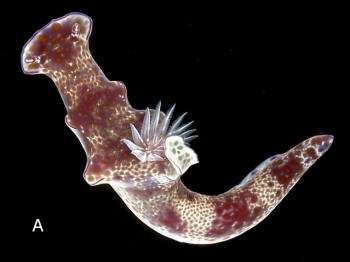
Ceratosoma tenue
Abraham, 1876
Order: NUDIBRANCHIA
Suborder: DORIDINA
Superfamily: EUDORIDOIDEA
Family: Chromodorididae
DISTRIBUTION
Tropical Indo-West Pacific.
PHOTO
A,B. Baie de Koumac, Koumac Region, New Caledonia, 3 m, sandy mud, Caulerpa beds, October 1993, A, 63mm, B, 150mm long alive.
C. juvenile, 20mm long, Coffs Harbour region, northern New South Wales, Australia, December 1990. D. Cymodocea grass beds, Dar es Salaam, Tanzania, February 1974, 68mm long animal with dorsal horn bitten? off. PHOTOS: Bill Rudman.
The two common tropical species of Ceratosoma, C. tenue and C. trilobatum (Gray), are variable in colour, and as both can have very similar colour patterns, considerable confusion has occurred in the past over the identity of specimens. Ceratosoma tenue can be characterised by the three mantle lobes on each side of the body. There is a large anterior lobe on either side of the head and a large lobe on each side by the gills. Between these is a smaller lobe which is joined by a ridge to the gill lobe, but not the head lobe. The edge of the lobes and the ridge joining the posterior lobes is usually outlined with a broken purple line. There is usually no broken purple line between the head lobe and the posterior lobes. Colour variation is very similar to that of C. trilobatum. It does appear that the purple border to the mantle and foot in C. tenue is always a dotted line whereas in C. trilobatum it is usually an unbroken line. Although this species can grow to more than 120mm in length, it is relatively smaller and more elongate than C. trilobatum.
Most species of Ceratosoma have a long recurved dorsal 'horn' which acts as a defensive lure attracting potential predators to the part of the animal which contains most of the distasteful chemicals stored from their food. See Ceratosoma brevicaudatum for photos of its conspicuously marked 'tail', especially in juveniles. This colour 'target' probably also attracts potential predators to the most distasteful part of the animal. See photo below (D) of Ceratosoma tenue from Dar es Salaam, in which whole dorsal horn has been cut off, probably bitten off. although not visible in the photo the animal had a distinct white amputation scar.
References:
•Rudman, W.B. (1984) The Chromodorididae (Opisthobranchia: Mollusca) of the Indo-West Pacific: a review of the genera. Zoological Journal of the Linnean Society 81: 115-273.
•Rudman, W.B. (1988b) The Chromodorididae (Opisthobranchia: Mollusca) of the Indo-West Pacific: the genus Ceratosoma J.E. Gray. Zoological Journal of the Linnean Society 93(2): 133-185.
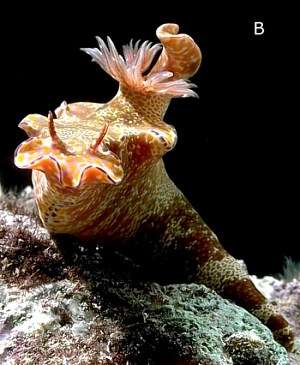
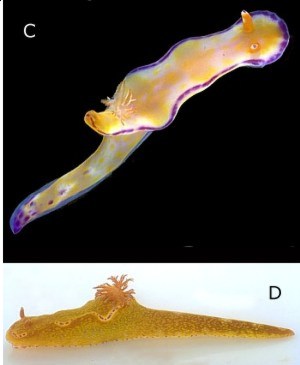
Rudman, W.B., 1999 (September 29) Ceratosoma tenue Abraham, 1876. [In] Sea Slug Forum. Australian Museum, Sydney. Available from http://www.seaslugforum.net/find/ceratenu
Related messages
Re: Ceratosoma tenue from Lembeh - with brittle-star
June 6, 2008
From: Teresa Zuberbühler
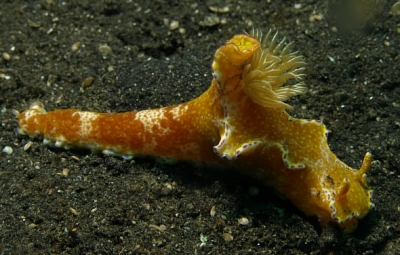
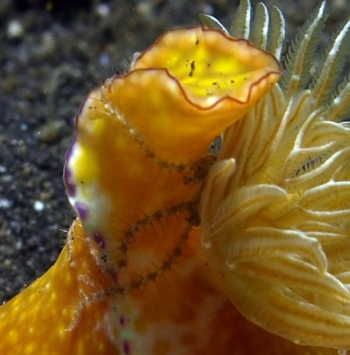
Dear Bill
I include photos of a Ceratosoma tenue with a brittle star between the gills and the "horn" on the back. I think, this is a good place to hide for such a small animal and on top it is transported from one food source to the other. I saw, you have a message with a picture of Notodoris gardineri (message #1873) where there was also a brittle star on the nudibranch.
Locality: Lembeh, 15m, Sulawesi, Indonesia, Pacific, 7. Juli 2007, Black sand. Photographer: Teresa (Zubi) Zuberbühler.
The third photo shows another animal, that likes to ride on top these nudibranchs, a Periclimenes imperator shrimp.
Greetings from Switzerland
Teresa Zubi
www.starfish.ch
webmaster@starfish.ch
Zuberbühler, T., 2008 (Jun 6) Re: Ceratosoma tenue from Lembeh - with brittle-star. [Message in] Sea Slug Forum. Australian Museum, Sydney. Available from http://www.seaslugforum.net/find/21623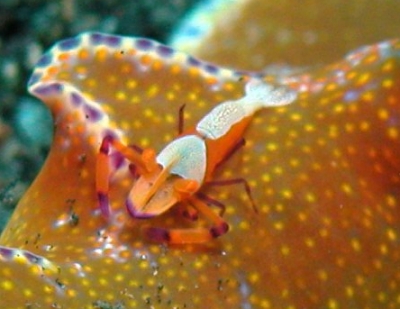
Dear Zubi,
Thanks for the photos. Concerning the brittle star. In the Notodoris example we can't really say that the brittle star was travelling on the body of the Notodoris. Some small brittle stars are often found on sponges, and in fact in one of the photos there are other brittle stars on the sponge colony which would suggest it could have crawled onto the Notodoris just because it was there. Brittle stars are detritus feeders, picking up small organic particles with the aid of mucus strings and their tube feet, so there is probably not much advantage in moving around with a nudibranch. It's possible the one on your Ceratosoma is feeding on its faecal pellets, but it could just be there by chance.
As I said in your message on Melibe [#21620], Periclimenes is found on a lot of large sea slugs. We are not sure what it feeds on, or what the advantage is for it to associate with slugs in this way.
Best wishes,
Bill Rudman
Ceratosoma tenue from Lembeh - feeding?
April 2, 2008
From: Kamal El Tawil
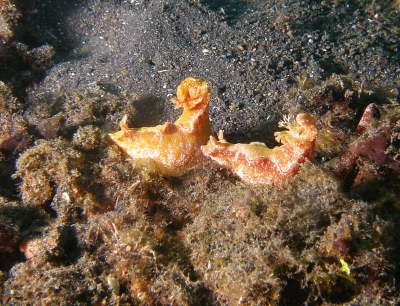
Dear Bill,
After reading your message [#20930], I went through my pictures and found some I have recently taken of Ceratosoma tenue. The animals were slowly moving on black sandy bottom and rubble. They don't seem to be feeding and I couldn't spot any sponges. Maybe you will spot a food source in the attached pictures as you did in Mike Krampf's picture (message #20164 )?
Locality: Lembeh Straight, N.E. Sulawesi, 10 metres, Indonesia, Celebes sea, 12 August 2007, Sandy bottom. Length: 100 mms. Photographer: Kamal El Tawil.
Kind regards,
Kamal El Tawil
www.coralworld.net
kamal@coralworld.net
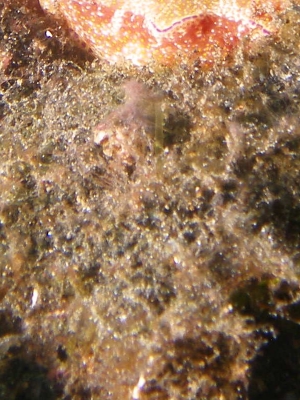
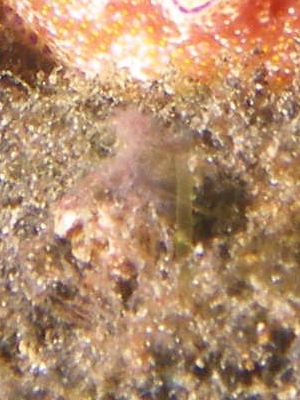
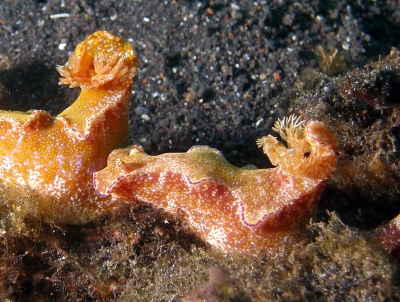
Dear Kamal,
I am pretty sure the 'lumpy' stuff the two Ceratosoma are sitting on is the remains of a sponge colony. It does no necessarily mean that the whole mass was sponge but it looks like there was a layer of sponge which had grown over the underlying material. from, the ittle we know about feeding in this genus, species of Ceratosoma appear to feed on sponges of the family Dysideidae. The colonies have small cone-like tubercles all over them and radiating from each cone is a radiating pattern of fibres. If you look at your photos you can see traces of such a radiating pattern, and in the middle right close-up photo there is a pinkish patch which lloks very like [see #19391].
Although I am pretty certain that these animals are on a destroyed - probably eaten by them - sponge colony, I can't identify the sponge with any certainty, but my guess is a dysideid.
Best wishes,
Bill Rudman
Ceratosoma tenue from sthn Queensland
October 12, 2007
From: Gary Cobb
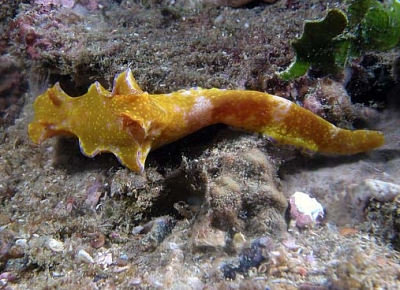
Hi Bill and everyone,
After reading Bruce's entry on Ceratosoma tenue feeding I thought you might like to see some records of this species found here at Old Woman Island and the Trench just off Mooloolaba on the Sunshine Coast.
Locality: Mooloolaba, Sunshine Coast, 12-18 m, Queensland, Australia, Pacific Ocean, 30 June 2007, Subtidal. Length: 60-120 mm. Photographer: Gary Cobb.
Cheers
Gary Cobb
gary@nudibranch.com.au
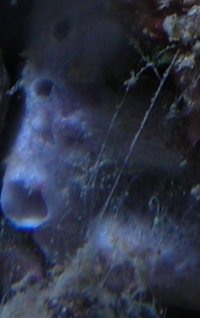
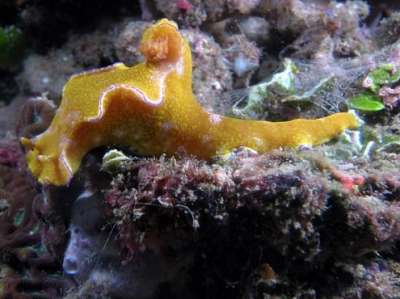
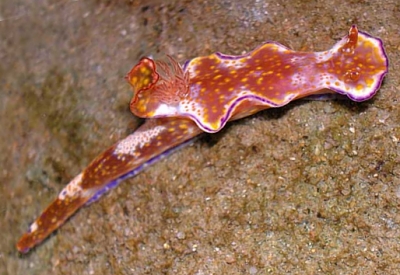
Thanks Gary,
The animal in the middle photo seems to be taking more than just a passing interest in the blue sponge. It's a bit difficult to see enough detail in the arrangement of the fibres, but I suspect it may be a dysideid sponge, which would match Bruce Wilkie's observations and the bluish sponge in Mike Krampf's message [#20164 ].
Best wishes,
Bill Rudman
Ceratosoma tenue feeding [3]
October 11, 2007
From: Bruce Wilkie
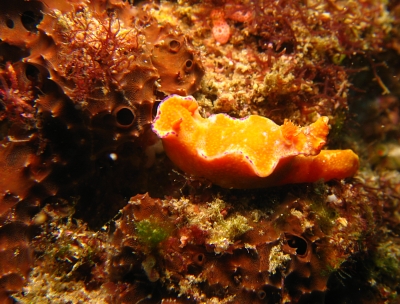
Hi Bill,
Here is another photo showing Ceratosoma tenue feeding.
Locality: Flat rock, Point lookout, North Stradbroke Island, 12 mts, Queensland, Australia. , Pacific ocean., 18 February 2007, Rocky reef, hard and soft corals, sponges.. Length: 50mm. Photographer: Bruce Wilkie.
Many thanks,
Bruce Wilkie.
brucedwilkie@yahoo.com.au
Wilkie, B., 2007 (Oct 11) Ceratosoma tenue feeding [3]. [Message in] Sea Slug Forum. Australian Museum, Sydney. Available from http://www.seaslugforum.net/find/20934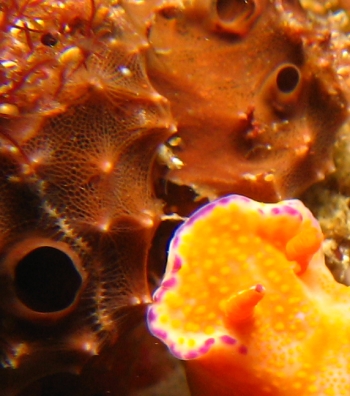
Dear Bruce,
Thanks for this record. As I discuss in your first message [#20930], this is a dysideid sponge which is also eaten by Ceratosoma moloch.
Best wishes,
Bill Rudman
Ceratosoma tenue feeding [2]
October 11, 2007
From: Bruce Wilkie
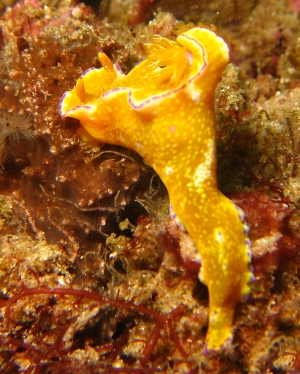
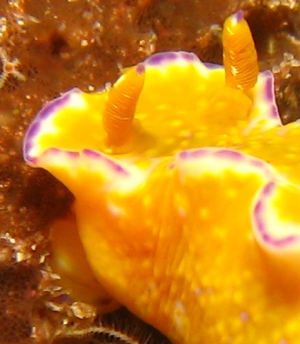
Hi Bill,
Here is another photo of Ceratosoma tenue feeding. I noticed the form does not have many feeding records of this species. Hope this helps to fill in some more gaps.
Locality: Flat rock, Point Lookout, Nth Stradbroke Island, 14 mts, Queensland, Australia. , Pacific ocean., 28 December 2006, Rocky reef, hard and soft corals, sponges. Photographer: Bruce Wilkie.
Many thanks,
Bruce Wilkie.
brucedwilkie@yahoo.com.au
Wilkie, B., 2007 (Oct 11) Ceratosoma tenue feeding [2]. [Message in] Sea Slug Forum. Australian Museum, Sydney. Available from http://www.seaslugforum.net/find/20933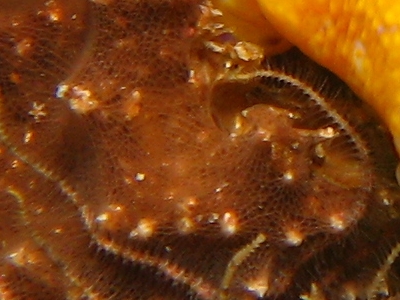
Dear Bruce,
Thanks for this record. As I discuss in your first message [#20930], this is a dysideid sponge which is also eaten by Ceratosoma moloch.
Best wishes,
Bill Rudman
Ceratosoma tenue feeding [1]
October 11, 2007
From: Bruce Wilkie
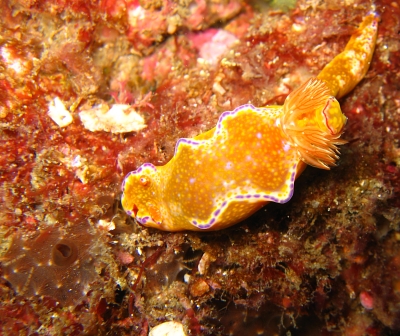
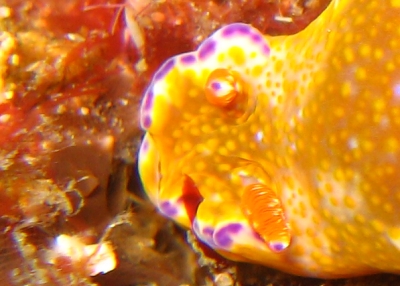
Hi Bill,
Looking through my files I came across these photos of Ceratosoma tenue feeding. I noticed the forum does not have many feeding records of this species. Hope they help to fill in some more gaps.
Locality: Flat rock, Point lookout, Nth Stradbroke island, 12mts, Queensland, Australia. , Pacific ocean., 21 May 2006, Rocky reef, hard and soft corals, sponges.. Length: 50mm. Photographer: Bruce Wilkie.
Many thanks,
Bruce Wilkie.
brucedwilkie@yahoo.com.au
Wilkie, B, 2007 (Oct 11) Ceratosoma tenue feeding [1]. [Message in] Sea Slug Forum. Australian Museum, Sydney. Available from http://www.seaslugforum.net/find/20930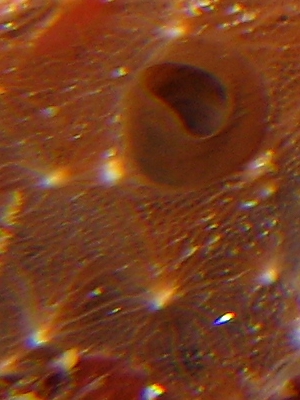
Dear Bruce,
Thanks for this valuable contribution. I have split your message into three separate messages so I can include close-up photos of the sponges. It is good to be able to provide clear visual identification of the sponge for each record.
In fact Mike Krampf's message [#20164] is the only feeding observation I know for this species and although almost certainly a species of Dysidea, the photo is not clear enough for a positive identification. Your photo here shows quite clearly that it is a species of Dysidea, and is the same species which you have recorded being eaten by Ceratosoma moloch [#17694, #17682 ].
It is also the same sponge as in your other two messages about C. tenue feeding [#20933, #20934]. I am pretty usre from my earlier conversations with Prof. Bergquist that this is an unnamed sponge species, but I will of course check that out with her.
Best wishes,
Bill Rudman
Ceratosoma tenue feeding? from Lembeh
July 17, 2007
From: Mike Krampf
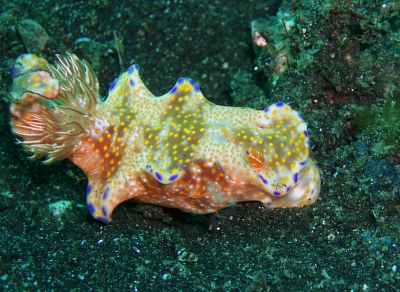
I thought you might find these pictures interesting. The Ceratosoma tenue appeared to be feeding, as it was extending and contracting what I assumed to be its mouth. I have no idea what it was eating since as you can see from the pictures it was just crawling across black sand.
Locality: Dive Site - Hairball in Lembeh Strait, 25 ft, North Sulawesi, Indonesia, Molucca Sea, 03 July 2007, Sandy bottom. Length: 8 cm. Photographer: Mike Krampf.
The other thing that I learned from this series of pictures was that the rhinopores can be retracted. As you can see, the first picture shows both while the second only shows one and the third shows the missing rhinopore reapearing.
I'm always amazed at things I notice by looking at pictures on my computer that I didn't notice at the time I was taking the picture.
Cheers,
Mike
mtkrampf@yahoo.com
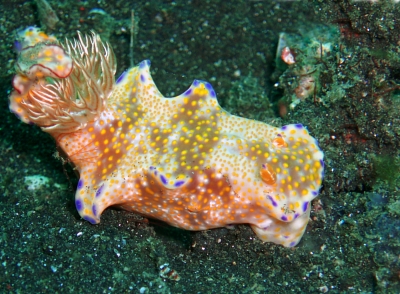

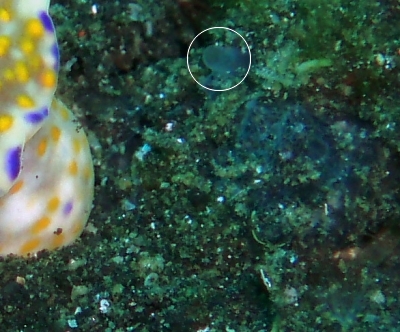
Dear Mike,
This is another very nice find.
Your message reminds me of a quote I think by Douglas Adams which goes something like "If it looks like a duck and quacks like a duck I think we have to consider the possiblity that we have an aquatic bird of the duck family ..".
Your Ceratosoma is certainly doing exactly what a feeding animal would be doing, so the question to ask is "where is the sponge?" If you look carefully just in front of the animal there are some blue-grey patches which I am sure are parts of a sponge colony partly covered in sand. I have ringed a tube which is one of the siphons for circulating water through the feeding cells of the colony.
This is the first record of Ceratosoma tenue feeding - unfortunately I can't identify the sponge. What it does do though is give us a better perspective on these dark volcanic? sandy bottoms which occur in many parts of Indonesia. In many photos the nudibranchs seem to be crawling over a sterile desert but your photo suggests that at least in some regions the sand may be a very thin layer hiding rich food resources beneath.
If you see a similar event again perhaps it would be worthwhile to try 'fanning' the sand to see if it hiding a sponge beneath. It might even enable you to take a photo we could use to identify the sponge.
Best wishes,
Bill Rudman
Ceratosoma tenue from Anilao, The Philippines
April 10, 2007
From: Paul Osmond
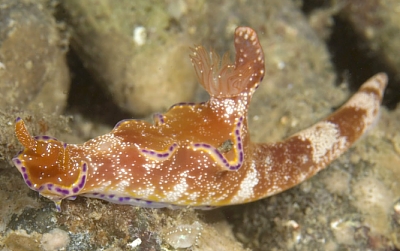
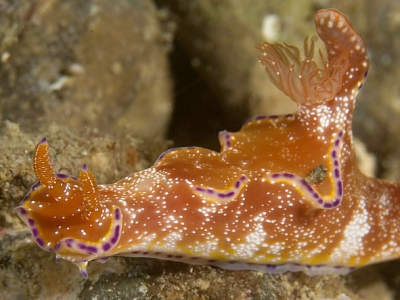
Hi Bill,
Had some very nice images of a Ceratosoma tenue that I wanted to share.
I found this specimen moving around on the muck dive at Basura in Anilao, The Philippines. The soil here is very dark, and this leads to a lot of unusual life living there. In the images you can see that it is moving over a rocky area, which would mean that the depth would be less than 10 m - below that the dive site is primarily sand.
Locality: 'Basura', Anilao, 10m, Batangas, The Philippines, 14 August 2006, Dark Soil, Muck Dive. Length: 30mm. Photographer: Paul T. Osmond.
Yours,
Paul
www.deepseaimages.com
marriard@deepseaimages.com
Osmond, P.T., 2007 (Apr 10) Ceratosoma tenue from Anilao, The Philippines. [Message in] Sea Slug Forum. Australian Museum, Sydney. Available from http://www.seaslugforum.net/find/19699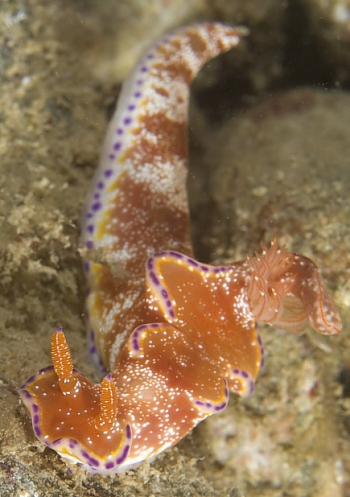
Thanks Paul,
Your animal clearly shows the large whitish glands around the edge of the 'dorsal horn' very well. I suggested that the dorsal horn was most probably a distasteful lure packed full of antifeedant chemicals obtained from their sponge food (Rudman, 1984, 1988, 1991). Recently, Ernesto Mollo and his colleagues (2005) have indeed shown that in Ceratosoma gracillimum, the sole ichthyotoxic feeding deterrent present was a sponge-derived sesquiterpene, and it was exclusively located in these mantle glands of the dorsal horn.
- Mollo, E., Gavagnin, M., Carbone, M., Guo, Y.-W. & Cimino, G. (2005) Chemical studies on Indopacific Ceratosoma nudibranchs illuminate the protective role of the dorsal horn. Chemoecology, 15: 31-36.
- Rudman, W.B. (1984) The Chromodorididae (Opisthobranchia: Mollusca) of the Indo-West Pacific: a review of the genera. Zoological Journal of the Linnean Society, 81(2- 3): 115-273.
- Rudman, W.B. (1988) The Chromodorididae (Opisthobranchia: Mollusca) of the Indo-West Pacific: the genus Ceratosoma J.E. Gray. Zoological Journal of the Linnean Society, 93(2): 133-185.
- Rudman, W.B. (1991) Purpose in Pattern: The evolution of colour in chromodorid nudibranchs. Journal of Molluscan Studies, 57(T.E.Thompson Memorial Issue): 5-21.
Best wishes,
Bill Rudman
Ceratosoma tenue mating
May 31, 2006
From: Bruce Wilkie
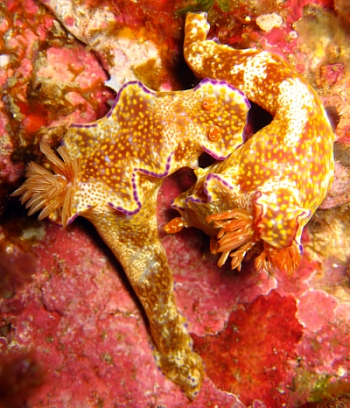
Hi Bill,
I am not certain if these animals are Ceratosoma tenue or Ceratosoma trilobatum, (I am leaning towards C. tenue) but which ever they are they are certainly mating.
Locality: Flat Rock North Stradbroke Island, 16 metres, Queensland Australia, Pacific ocean, 21 May 2006, rocky reef with sponges, hard & soft corals . Length: 60 mm. Photographer: Bruce Wilkie.
Many Thanks,
Bruce Wilkie.
brucedwilkie@yahoo.com.au
Wilkie,B, 2006 (May 31) Ceratosoma tenue mating. [Message in] Sea Slug Forum. Australian Museum, Sydney. Available from http://www.seaslugforum.net/find/16684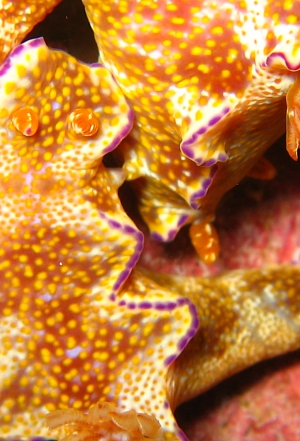
Dear Bruce,
These are definitely C. tenue. The three mantle lobes down each side of the body are characteristic of this species. In C. trilobatum there is only the 'head' lobe and the large one on each side of the gills. The name trilobatum [= three lobes] refers to the two large lobes, one on either side of the gills, and the recurved dorsal horn, just behind the gills.
When I was revising the chromodorids the species of Ceratosoma were quiye a challenge because at least three species, C. trilobatum, C. tenue, and C. gracillimum showed a great deal of colour variation, but the three species had the same, or very similar colour patterns. There were also other names referring to colour variants of one or other of the species. This group only began to make sense when I ignored the colour and used the shape of the mantle. Ignoring the colour was a very difficult thing to do, because in every other chromodorid genus, the colour is vital. This is the first time I have seen this species mating, so I am very pleased to see that both partners have the three lobes of 'typical' C. tenue. It would definitely been back to the drawing board if one partner was like this, and the other had the lobes of C. trilobatum or C. gracillimum.
Best wishes,
Bill Rudman
Ceratosoma tenue with eggs from Buton Island
December 1, 2005
From: Linda Ianniello
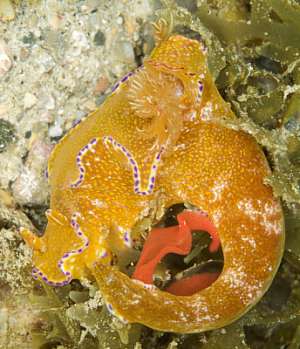
Here is a record of Ceratosoma trilobatum with eggs.
Locality: Buton Beach, Indonesia, Buton Island, Banda Sea. 2 November 2005. Sand, rubble. Photographer: Linda Ianniello
Regards,
Linda I.
lindai1@bellsouth.net
Ianniello, L., 2005 (Dec 1) Ceratosoma tenue with eggs from Buton Island. [Message in] Sea Slug Forum. Australian Museum, Sydney. Available from http://www.seaslugforum.net/find/15375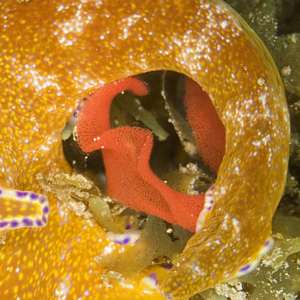
Dear Linda,
Although the animal is in an awkward position there is a small secondary lobe on each side of the mantle edge between the gills and the rhinophores which suggests that this is C. tenue rather than C. trilobatum. We have very little information on egg ribbons in species of Ceratosoma so every photo is valuable. Interestingly we recently had a message from Mary Jane Adams [#15013] with a photo. The egg mass is identical in colour bit decidedly 'frilly' along the edge
Best wishes,
Bill Rudman
Ceratosoma tenue laying eggs
October 26, 2005
From: Mary Jane Adams
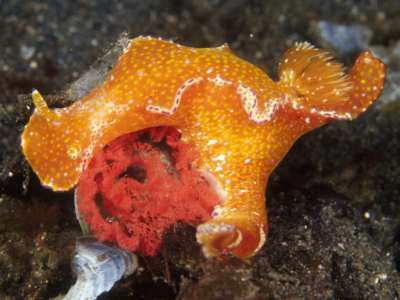
Hi Bill,
It looks like Ceratosoma tenue uses the curled up 'tail' of its foot to form a tight, neat egg coil.
Locality: Sulawesi, Indonesia. Lembeh Strait. Depth: 10 meters. Length: 50 mm. 4 June 2005. Sand slope. Photographer: M. J. Adams
Best regards,
Mary Jane
divepng@yahoo.com
Adams, M.J., 2005 (Oct 26) Ceratosoma tenue laying eggs. [Message in] Sea Slug Forum. Australian Museum, Sydney. Available from http://www.seaslugforum.net/find/15013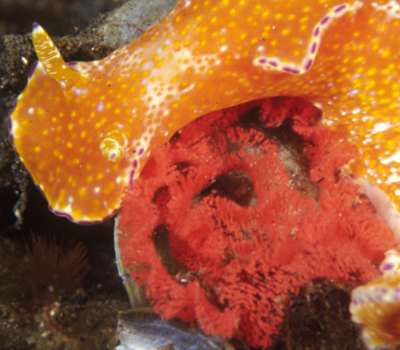
Thanks Mary Jane,
It certainly looks as though it is using its tail. Other nudibranchs use their foot. I often wonder just how such 'blunt tools' can be used by an animal of such little brain to create such meticulous spirals
Best wishes,
Bill Rudman
Ceratosoma tenue from Sth Africa
February 23, 2004
From: Riaan Marx
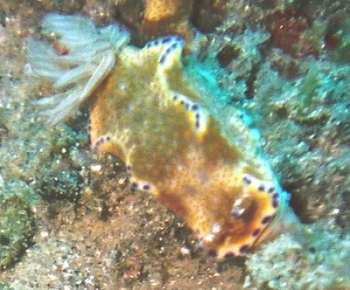
Hi Bill.
I photographed this critter at Sodwana, [KwaZulu Natal], South Africa.
Could you please assist with an identification?
Thanks!
Riaan
rmarx@ms.cs.co.za
Marx, R., 2004 (Feb 23) Ceratosoma tenue from Sth Africa. [Message in] Sea Slug Forum. Australian Museum, Sydney. Available from http://www.seaslugforum.net/find/12264Dear Riaan,
This is Ceratosoma tenue. The pair of 'bumps' on the mantle edge between the gills and the head are a good character of this species which has often been mistaken for C. trilobatum.
Best wishes
Bill Rudman
Ceratosoma tenue from Sodwana, Sth Africa
February 5, 2004
From: Charles Rowe
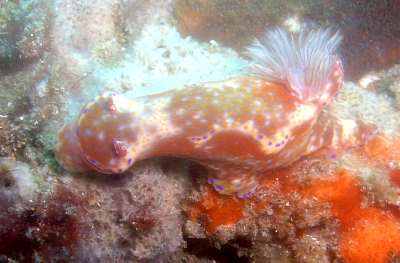
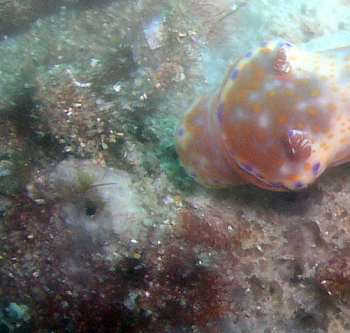
Hi Bill,
Here is another nudi which I photographed in January at Sodwana in Kwa Zulu Natal, South Africa.
Stringer Reef, Sodwana. 7 January 2004.
All in all our short holiday at Sodwana was very fruitful with shots of a flatworm I hadn't seen before, a paperfish and lovely cleaner shrimps.
Best wishes
Charles Rowe
bumff@mweb.co.za
Rowe, C., 2004 (Feb 5) Ceratosoma tenue from Sodwana, Sth Africa. [Message in] Sea Slug Forum. Australian Museum, Sydney. Available from http://www.seaslugforum.net/find/12132Thanks Charles,
This is Ceratosoma tenue. It can be distinguished by the extra bump on the mantle edge halfway down each side, between the gills and the rhinophores. I have included a close-up of the head, because it shows that the animal is feeding. In species of Ceratosoma the oral tube is brightly coloured rather than colourless as in species of Chromodoris. The rock-like 'lump' it is crawling on is a sponge colony. Unfortunately I doubt if there is enough detail to identify the sponge
Best wishes
Bill Rudman
Ceratosoma tenue with egg ribbon
June 5, 2003
From: Danny Van Belle
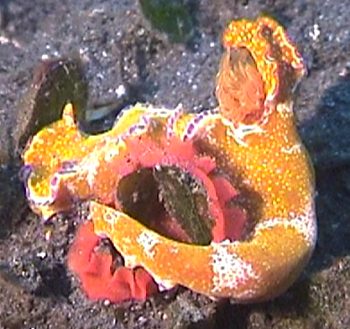
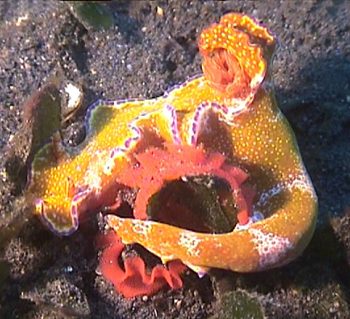
Dear Bill,
Here is a photo of a Ceratosoma with egg ribbon.
Depth 3m at Lembeh Strait - N. Sulawesi Indonesia, April 2002.
Cheers,
Danny Van Belle
dannyvb@hotmail.com
Van Belle, D., 2003 (Jun 5) Ceratosoma tenue with egg ribbon. [Message in] Sea Slug Forum. Australian Museum, Sydney. Available from http://www.seaslugforum.net/find/9915Thanks Danny,
This is Ceratosoma tenue. I'm glad to get a photo of it laying eggs as there are very few records of egg ribbons for tropical species of Ceratosoma.
Best wishes,
Bill Rudman
Ceratosoma tenue from Sth Korea
May 30, 2003
From: Dong Bum Koh
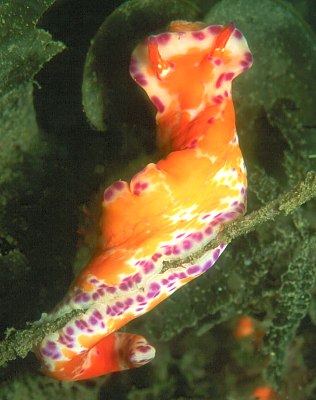
Dear Bill,
Here is a photo of Ceratosoma tenue that I took at Moon islet, Cheju Island on 18 May 2003.
5m depth. W/T:17 degrees
May be its useful scene understanding of foot actions.
Thank you very much for your kind comments.
Best regards,
Dong Bum Koh
drkoh@seasee.co.kr
Koh, D.B., 2003 (May 30) Ceratosoma tenue from Sth Korea. [Message in] Sea Slug Forum. Australian Museum, Sydney. Available from http://www.seaslugforum.net/find/10002Thanks Dong Bum,
At this angle I can only guess that it is Ceratosoma tenue rather than Ceratosoma trilobatum. The foot on most molluscs is shaped to crawl on flat, or reasonably flat surfaces, but when they are on a very narrow object such as this stalk, the edge tend to fold around the narrow object so that the snail or slug stays attached, not just through gravity and the stickiness of the mucous trail, but through the muscles on the edge of the foot grasping the stalk much like we would do with a thumb and forefinger. Slugs and snails that always live on narrow plant stalks or plant-like animal colonies often seem to produce a stickier mucus whih I assume helps them to stay on their food even in strong currents.
Best wishes,
Bill Rudman
A Ceratosoma convention
May 28, 2003
From: Danny Van Belle
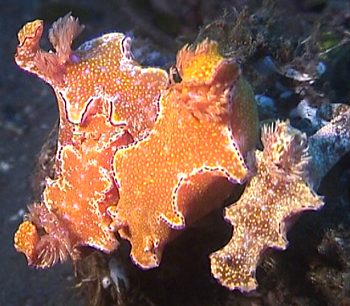
Hi again Bill,
Here are 4 Ceratosoma together and they all don't look like the same species. Can you give me some more info about what I see here?
Thanks
Danny Van Belle
dannyvb@hotmail.com
Van Belle, D., 2003 (May 28) A Ceratosoma convention. [Message in] Sea Slug Forum. Australian Museum, Sydney. Available from http://www.seaslugforum.net/find/9914Dear Danny,
These are all the same species. They are Ceratosoma tenue. This species can be identified by its extra pair of mantle lobes between the gills and the head. Unlike other chromodorids, colour differences in species of Ceratosoma don't seem to be important. What are they doing? Well the three on the left could certainly be interested in mating and the two furthest to the left could be mating.
Best wishes,
Bill Rudman
Ceratasoma tenue from North Sulawesi
October 12, 2002
From: Marli Wakeling
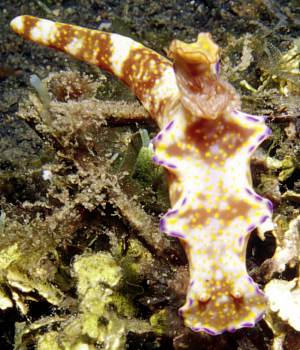
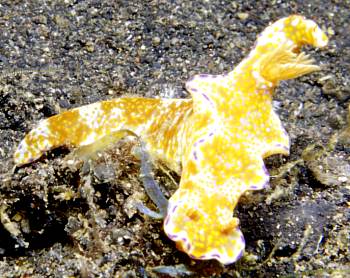
Hi Bill,
I had difficulty telling these apart from from Ceratosoma trilobatum, except for the three protrusions behind the head, which I believe is a defining trait. We found both species at night.
Location: Jahir, Lembeh Straight, Suluwesi, Indonesia
Date: July 2002
Depth: 30 feet
Length: 10 cm.
Photographs: Marli Wakeling
Marli
scubamrli@excite.com
Wakeling, M., 2002 (Oct 12) Ceratasoma tenue from North Sulawesi. [Message in] Sea Slug Forum. Australian Museum, Sydney. Available from http://www.seaslugforum.net/find/8127Thanks Marli,
The extra pair of lateral lobes is a good external feature of this species. Both C. tenue and C. trilobatum show a similar range of colour variation. Just remember that trilobatum means 'three lobes' - that is the two lateral ones and the larger posterior lobe - and they shouldn't be a problem.
Cheers,
Bill Rudman
Variation: Ceratosoma tenue
August 12, 2001
From: Valda Fraser
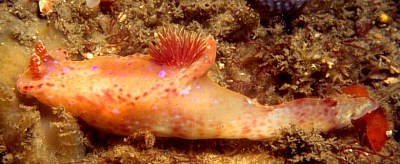
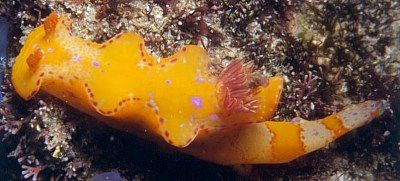
Dear Bill,
On a particular reef I saw quite a few dark orange individuals crawling about, but only one pale one. Why is it the odd man out? I thought that it may be sick, or may have eaten something to alter the body colour? What do you think?
Locality: Brazenhead, Transkei, Eastern Cape, SOUTH AFRICA, 25m
Date: July 2001
Size: 60mm
Thanks,
Valda Fraser
valdafraser@mweb.co.za
Fraser, V., 2001 (Aug 12) Variation: Ceratosoma tenue. [Message in] Sea Slug Forum. Australian Museum, Sydney. Available from http://www.seaslugforum.net/find/4970Dear Valda,
This colour variant is very similar to one in an earlier message. I assume that these colour differences are just part of the genetic variation within the species. It is interesting that the southern Australian species Ceratosoma brevicaudatum has a similar range in colour variation.
Best wishes,
Bill Rudman.
Ceratosoma tenue from Southern Mozambique
December 19, 2000
From: Ian Miller
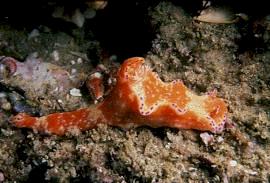
Hi Bill,
I am new to your site, and find the easy interactiveness of it amazing. I found this nudibranch on a small shallow sandstone reef, 12 m, at Ponta D Ouro in Southern Mozambique in January of this year. Length 7 cm. I have also recently seen it on Aliwal Shoal on the Natal South Coast at 25 m.
Thanks to your site I am fairly confident on my ID as Ceratosoma tenue. Am I right?
I hope your recent expedition was a success.
Cheers for now
Ian
diverian@xsinet.co.za
Miller, I., 2000 (Dec 19) Ceratosoma tenue from Southern Mozambique. [Message in] Sea Slug Forum. Australian Museum, Sydney. Available from http://www.seaslugforum.net/find/3296Dear Ian,
Glad you like the Forum. I usually try and answer questions a bit quicker but as you know I have been away. Your identification is correct, C. tenue being found right throughout the Indo-West Pacific.
Any other records you have from Mozambique, even common things would be of interest as there are few published records from that part of the world.
best wishes,
Bill Rudman.
Mystery slug from Indonesia
October 29, 2000
From: Marli Wakeling
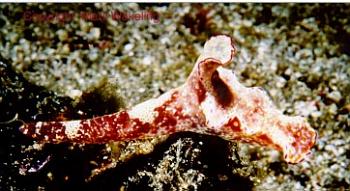
Dear Bill
This was found on a night dive in Flores, Indonesia in 1999. I think it might be a Sea Hare, but have had no luck in finding a reference. I was wondering if it might be a juvenile Spanish Dancer, as some large specimens were found in the same area.
Marli Wakeling
scubamarli@excite.com
Wakeling, M, 2000 (Oct 29) Mystery slug from Indonesia. [Message in] Sea Slug Forum. Australian Museum, Sydney. Available from http://www.seaslugforum.net/find/3202Dear Marli,
This is neither a Sea Hare nor a juvenile Spanish Dancer. It is in fact a very specialised relative of Chromodoris and Hypselodoris called Ceratosoma tenue
Best wishes
Bill Rudman.
Ceratosoma tenue from South Africa
November 5, 1999
From: Valda Fraser
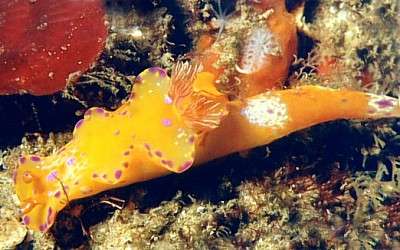
I dive on the south coast of KwaZulu Natal, South Africa, an area which is exceptionally rich in nudibranch life. I have been able to identify many of the animals I have photographed, however I am battling to find information about some of them. Please could you help me.
Kind regards,
Valda Fraser
iti04937@mweb.co.za
Fraser, V., 1999 (Nov 5) Ceratosoma tenue from South Africa. [Message in] Sea Slug Forum. Australian Museum, Sydney. Available from http://www.seaslugforum.net/find/1480Dear Valda,
I am happy to help. This is Ceratosoma tenue which is characterised by the the third lobe on each side of the mantle between the gills and the rhinophores. Like Ceratosoma trilobatum the body colour in this species is very variable. In most genera of the Chromodorididae, anatomy and body shape are fairly conservative, differences in colour pattern being the best way to differentiate species. In Ceratosoma however, colour pattern is very variable within most species and the best way to differentiate species is to compare their body shape.
Welcome to the Forum. It would be very useful if you could include some basic information on the locality, date of collection and size.
Best wishes,
Bill Rudman.
Re: Ceratosoma tenue from South Africa
November 5, 1999
From: Valda Fraser
Bill,
Here is the additional information on my photo.
Locality: South Coast of Kwa Zulu Natal, South Africa, near Port Shepstone.
Low profile scattered rocky reef
Depth: 38m
Date: July 1999
Size: 80mm
Kind regards,
Valda Fraser
iti04937@mweb.co.za
Fraser, V., 1999 (Nov 5) Re: Ceratosoma tenue from South Africa. [Message in] Sea Slug Forum. Australian Museum, Sydney. Available from http://www.seaslugforum.net/find/1491